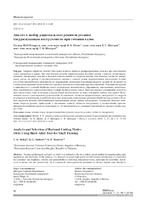Анализ и выбор рациональных режимов резания твердосплавным инструментом при точении валов

Date
2018Publisher
Another Title
Analysis and Selection of Rational Cutting Modes while Using Hard-Alloy Tool for Shaft Turning
Bibliographic entry
Шелег, В. К. Анализ и выбор рациональных режимов резания твердосплавным инструментом при точении валов = Analysis and Selection of Rational Cutting Modes while Using Hard-Alloy Tool for Shaft Turning / В. К. Шелег, Д. Г. Шатуров, Г. Ф. Шатуров // Наука и техника. – 2018. – № 1. - С. 14-20.
Abstract
Токарная обработка деталей типа валов является наиболее распространенным методом при изготовлении узлов, механизмов и машин. При этом высокое качество обработки валов точением связано с износом лезвия твердосплавного инструмента, который в большой степени зависит от скорости резания. Как известно, стойкость инструмента, ресурс его работы и производительность связаны с износом лезвия твердосплавного инструмента. Однако отсутствие аналитической зависимости по определению оптимальной величины скорости резания не позволяет на стадии проектирования технологического процесса назначить оптимальные режимы обработки. Режущий инструмент в зависимости от условий обработки может подвергаться механическому, абразивному, адгезионному, окислительному (химическому), термоусталостному и диффузионному видам износа. При этом процесс изнашивания состоит из двух видов износа, один из которых в определенный момент влияет на износ в большей степени, чем другой. На основании анализа существующих представлений об изменении стойкости твердосплавного инструмента от скорости резания при точении валов разработана методика назначения рациональных режимов обработки для средних и больших скоростей резания, обеспечивающих максимальный ресурс работы инструмента. Установлен диапазон изменения скорости резания, приводящий к увеличению периода стойкости инструмента и соответственно производительности обработки валов из стали марки ст. 45 инструментом со сменными пластинами из твердого сплава марки Т15К6.
Abstract in another language
Turning machining of such parts as shafts is considered as the most widely-spread method formanufacturing units, mechanisms and machinery. While doing so it is necessary to ensure high quality of shaft turning with the help of a hard-alloy tool (accuracy and roughness, stability and predictability of steel edge dimensional wear), maximum tool durability, resource of its service life and productivity. As it is known all these operational parameters of the tool depend very heavily on cutting speed. However absence of an analytical dependence for determination of optimum cutting speed value does not per permit to prescribe optimum operational modes at the stage of technology design process. The cutting tool can be subjected to mechanical, anrasive, adhesive, oxidation (chemical), thermal-fatigue and diffusion wear types depending on turning conditions. In this case wearing process consists of two wear types and one of them influences at a certain point on wearing process to a greater extent than the other one. Methodology for prescription of rational turning modes for medium and high cutting speeds ensuring maximum resource of the tool operation has been developed in the paper and it has been based on the analysis of the existing viewpoints about changes in the hard-alloy tool durability due to cutting speed while turning shafts. The range of cutting speed changes has been determined in the paper and it leads to an increase of the tool durability period and, correspondingly, turning productivity of 45 steel grade shafts while using the tool with T15K6-hard-alloy replaceable inserts.
View/
Collections
- №1[10]
